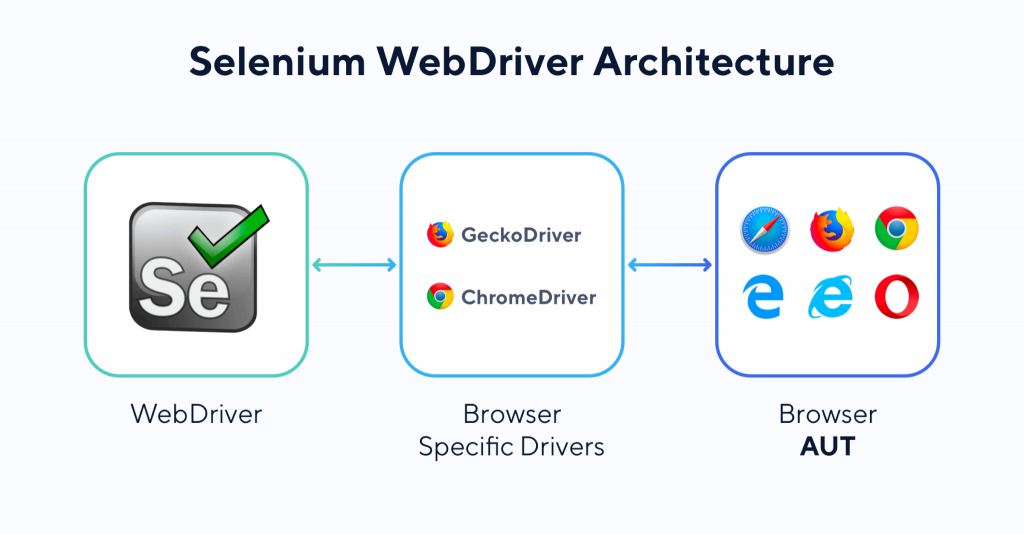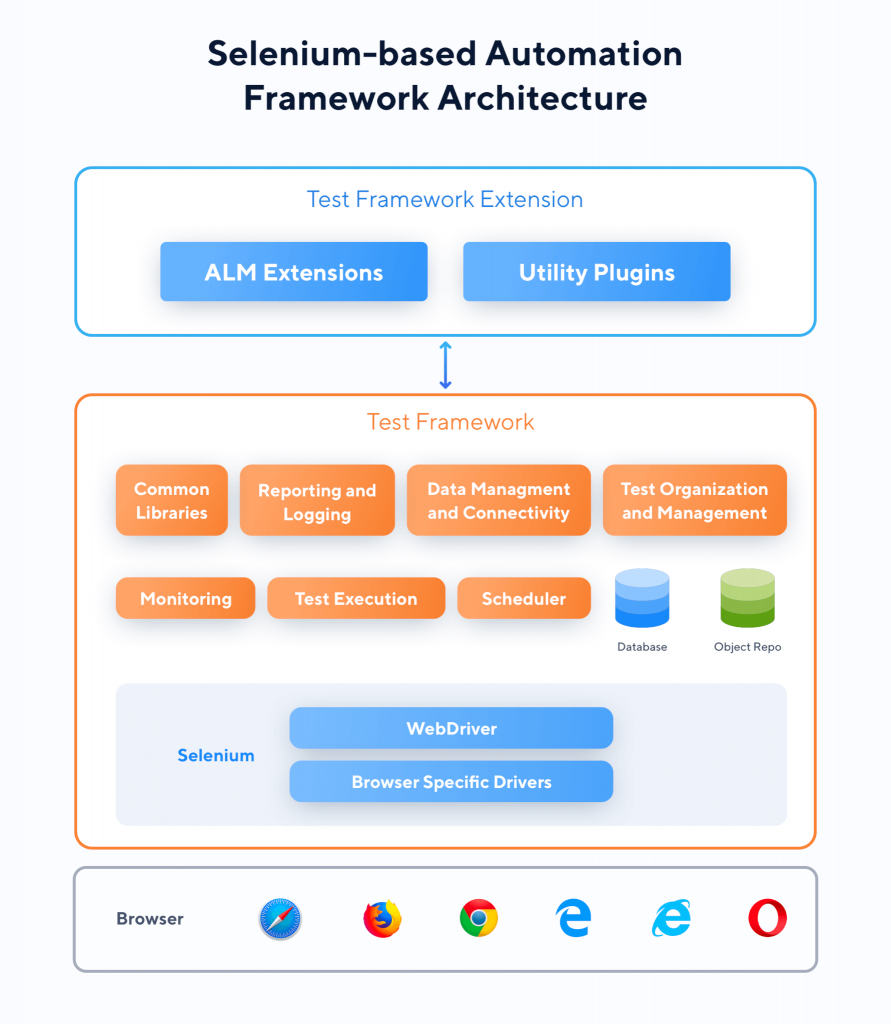In the mid-2000s, Selenium was released as a Web browser plugin for recording and replaying Web browser interactions. It has certainly been the most widely used test automation tool since then. According to a survey of the automated testing community, more than 80% of those questioned use the framework.
- Selenium is an open-source framework for Web-based automation, consisting of Selenium WebDriver, Selenium IDE, and Selenium Grid.
- Selenium IDE is a browser plugin that records and playbacks user interactions.
- Selenium Grid enables WebDriver to execute automation tests on computers, browsers, and OS systems.
Because of the features it provides, Selenium is widely used in the software automation industry. For starters, it is developer-friendly, allowing developers to create and test applications in any programming language of their choice. Moreover, the framework is a cross-browser and cross-operating system solution, allowing teams to automate tests across many browsers and operating systems.
The Architecture of Selenium WebDriver
The Selenium WebDriver architecture is comprised of three components: the WebDriver, Browser Specific Drivers or Drivers, and the Browser. In RESTful services, these components communicate bidirectionally or two-way, sending HTTP requests and receiving HTTP answers.

- WebDriver offers language-specific client libraries, often known as language bindings, for writing automation scripts and running script commands in the browser utilizing Drivers. Thanks to new language bindings, Selenium can now support scripting in a variety of languages, including Java, C#, Python, Ruby, and JavaScript.
- Browser Specific Drivers, often known as Drivers, are in charge of running the browser itself via providing WebDriver requests. Third parties can implement and extend drivers. GeckoDriver for Firefox and ChromeDriver for Chrome are two browser driver implementations.
- Browser component accepts requests from the Drivers component to drive interactions on the application under test (AUT). Selenium is compatible with all major browsers, including Chrome, Firefox, Internet Explorer, Opera, and Safari.
WebDriver may run independently of the Drivers and Browser components. WebDriver connects to these components remotely through Selenium Server or Remote WebDriver in this setup. Selenium can now run automated tests on many browsers and PCs at the same time.
Advantages of this structure
The architecture is jumbled. Three components communicate with one another using the HTTP protocol and RESTful Web services. This feature allows an element to function independently of its neighbors. Changes and enhancements to one component may be made quickly and without affecting the others. Selenium’s loosely coupled architecture allows it to be platform- and language-neutral.
Moreover, the architecture is accessible. Selenium WebDriver is a W3C Recommendation, which allows for many contributions from the software community.
These architectural characteristics result in a spate of significant Selenium characteristics:
- Compatibility across platforms and languages. Because the Drivers component is accessible in many implementations, users may execute automation scripts on a variety of operating systems and browsers. Selenium automation scripts can be written in any language as long as language bindings in the WebDriver are available.
- Developer friendly. Because Selenium supports many languages, developers may create automation scripts in the language of their choice. If required, they may additionally build and include a binding library in the WebDriver component to aid a new scripting language.
- Open for extension. The Selenium architecture allows for language binding expansions by supporting additional test scripting languages or Drivers for new browsers.
- Open for integration with a test automation framework. A new test automation framework may be constructed on top of Selenium by utilizing it as an engine for executing scripts for Web automation, as demonstrated in the figure below.
The Need for a Selenium Alternative
When viewed through the viewpoint of those who do not have programming or advanced technical skills, Selenium’s benefits in helping programming are really its disadvantages. Because of its difficult programming, many testers regard Selenium as a barrier to getting started with test automation. As a result, many testers face a steep learning curve when using Selenium directly.
Selenium also has a weakness in terms of maintaining and organizing test resources such as test scripts, data, and test objects. There are no methods for separating automation scripts from test data, resulting in high test script maintenance costs and issues with test script and test data reusability.
These constraints assist to explain the recent fast development of Selenium-based solutions in the software test automation market. Teams and businesses desire a solution that offers out-of-the-box testing capabilities without needing them to create their own Selenium-based framework to begin the automation process.
The Structure of Selenium-based Test Frameworks

A number of test automation frameworks have been built on top of Selenium. These frameworks aim to address some of Selenium’s limitations, such as the lack of reporting, logging, monitoring, and reusing test automation assets. Importantly, these frameworks help overcome the difficulty of designing and launching an automation effort with Selenium.
The diagram below presents various components of a typical test framework that uses Selenium as its test execution engine.
This Selenium-based framework is used by many contemporary automation systems. Katalon Studio, CrossBrowserTesting, QMetry Automation Studio, Lambda Test, and Sauce Labs are a few examples. Many of these solutions go it a step further by adding Appium as a mobile app test automation engine, allowing them to handle both web and mobile automation in a single tool.
New Test Automation Solution
Katalon Studio is a test automation tool built on top of Selenium with an IDE, yet it requires little to no programming skills from users to get started with testing.
It incorporates all of the tests as mentioned above framework features while also extending test environments to mobile apps via Appium integration. In addition, Katalon Studio also allows users to migrate almost everything from Selenium.
The tool covers all environments extensively, including online, mobile, API, and desktop testing on all platforms and operating systems. You may use the tool’s ready-made project templates, keyword libraries, and object repositories to get started with automation rapidly. The built-in scripting mode and reporting tool in Katalon allow customers to extend testing even further.
The nature of testing with Selenium and Katalon Studio differs to some extent, but each tool will fit into the demands and aims of testing for various teams. With the movement towards Agile culture is rising in recent years, codeless testing tools would be a better choice to move fast with guaranteed quality.
Conclusion
This post will go through the Selenium WebDriver architecture and explain why this framework is so popular in the Web automation world. The key characteristics of the architecture are simplicity, robustness, loose coupling, and openness.
Read more: Introduction to Automation Testing.












